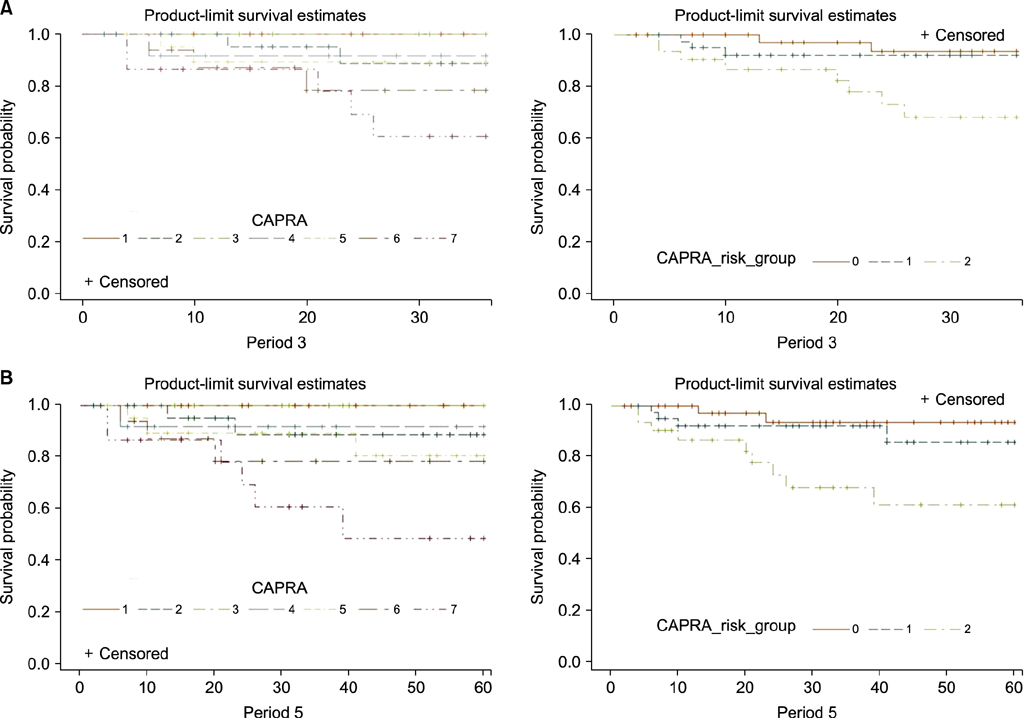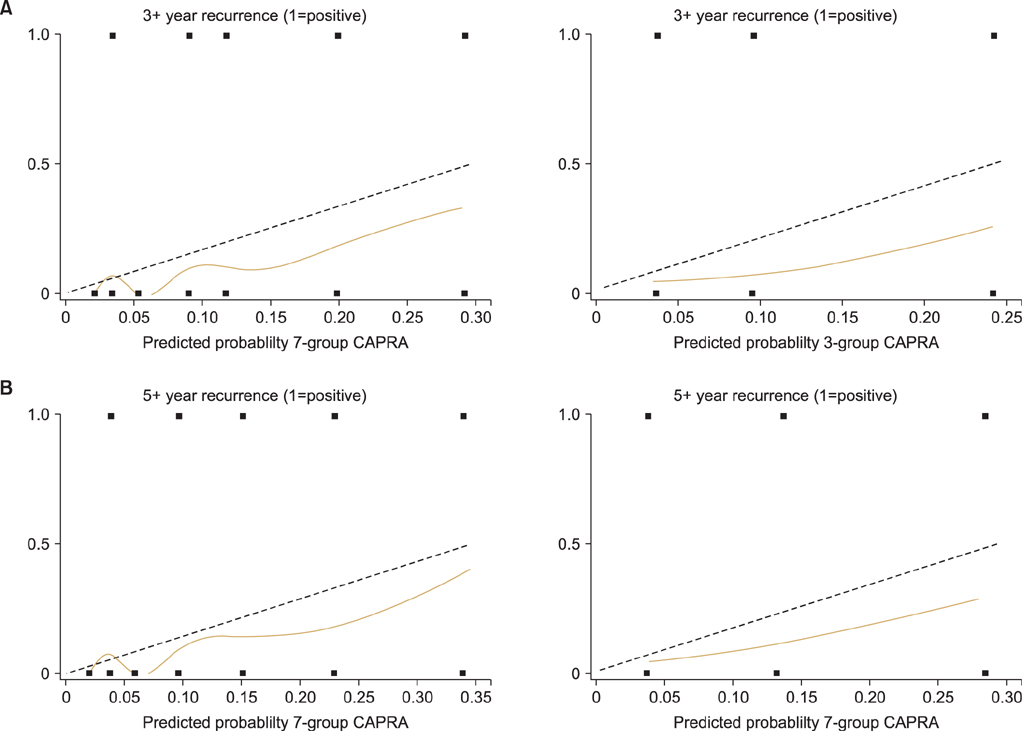Korean J Urol.
2014 May;55(5):321-326. 10.4111/kju.2014.55.5.321.
Predictive Value of the Cancer of the Prostate Risk Assessment Score for Recurrence-Free Survival After Radical Prostatectomy in Korea: A Single-Surgeon Series
- Affiliations
-
- 1Department of Urology, Inje University Busan Paik Hospital, Inje University College of Medicine, Busan, Korea. prosdoc@hanmail.net
- KMID: 1988409
- DOI: http://doi.org/10.4111/kju.2014.55.5.321
Abstract
- PURPOSE
To evaluate the validity of the cancer of the prostate risk assessment (CAPRA) score, a newly developed nomogram for preoperative prediction of recurrence after radical prostatectomy, in a single institution in Korea.
MATERIALS AND METHODS
We retrospectively studied 115 men who had undergone radical prostatectomy as the first treatment for localized prostate cancer. The validity of the CAPRA score for the prediction of recurrence-free survival (RFS) and pathologic outcome was evaluated by using Kaplan-Meier analysis and a proportional hazards regression model. A seven-group model and a three-group model were used for the results.
RESULTS
None of the variables of the CAPRA score was favorable compared with the previously reported data. The three-group model was significantly related with 3- and 5-year RFS (p<0.05), but the seven-group model was not. The concordance indices of the CAPRA score were 0.74 and 0.77. Of four components excluding the clinical T stage, three independently predicted RFS (age, Gleason sum, and percentage of positive biopsies). The CAPRA score was significantly related to the margin status, extracapsular extension, and seminal vesicle invasion in both the seven- and three-group models. In the three-group model, pathologic outcomes were more strongly related, especially a higher risk of seminal vesicle invasion.
CONCLUSIONS
The CAPRA score showed high accuracy for predicting RFS. In particular, the three-group model was more useful for predicting RFS and pathologic outcomes. Therefore, the CAPRA score may be a useful prediction model for risk stratification and may help clinicians to develop localized prostate cancer treatment.
Keyword
MeSH Terms
Figure
Cited by 2 articles
-
The Within-Group Discrimination Ability of the Cancer of the Prostate Risk Assessment Score for Men with Intermediate-Risk Prostate Cancer
Ho Won Kang, Hae Do Jung, Joo Yong Lee, Jong Kyou Kwon, Seong Uk Jeh, Kang Su Cho, Won Sik Ham, Young Deuk Choi
J Korean Med Sci. 2018;33(5):. doi: 10.3346/jkms.2018.33.e36.CDC6 mRNA Expression Is Associated with the Aggressiveness of Prostate Cancer
Ye-Hwan Kim, Young Joon Byun, Won Tae Kim, Pildu Jeong, Chunri Yan, Ho Won Kang, Yong-June Kim, Sang-Cheol Lee, Sung-Kwon Moon, Yung-Hyun Choi, Seok Joong Yun, Wun-Jae Kim
J Korean Med Sci. 2018;33(47):. doi: 10.3346/jkms.2018.33.e303.
Reference
-
1. Bray F, Lortet-Tieulent J, Ferlay J, Forman D, Auvinen A. Prostate cancer incidence and mortality trends in 37 European countries: an overview. Eur J Cancer. 2010; 46:3040–3052.2. Siegel R, Naishadham D, Jemal A. Cancer statistics, 2013. CA Cancer J Clin. 2013; 63:11–30.3. Statistics Korea [Internet]. Daejeon: Statistics Korea;2012 Mar 10. Available from: http://kostat.go.kr/portal/english/index.action.4. Jung KW, Park S, Kong HJ, Won YJ, Lee JY, Seo HG, et al. Cancer statistics in Korea: incidence, mortality, survival, and prevalence in 2009. Cancer Res Treat. 2012; 44:11–24.5. Tewari A, Raman JD, Chang P, Rao S, Divine G, Menon M. Long-term survival probability in men with clinically localized prostate cancer treated either conservatively or with definitive treatment (radiotherapy or radical prostatectomy). Urology. 2006; 68:1268–1274.6. Wong YN, Mitra N, Hudes G, Localio R, Schwartz JS, Wan F, et al. Survival associated with treatment vs observation of localized prostate cancer in elderly men. JAMA. 2006; 296:2683–2693.7. Wei JT, Dunn RL, Sandler HM, McLaughlin PW, Montie JE, Litwin MS, et al. Comprehensive comparison of health-related quality of life after contemporary therapies for localized prostate cancer. J Clin Oncol. 2002; 20:557–566.8. Cooperberg MR, Pasta DJ, Elkin EP, Litwin MS, Latini DM, Du Chane J, et al. The University of California, San Francisco Cancer of the Prostate Risk Assessment score: a straightforward and reliable preoperative predictor of disease recurrence after radical prostatectomy. J Urol. 2005; 173:1938–1942.9. Cooperberg MR, Broering JM, Carroll PR. Risk assessment for prostate cancer metastasis and mortality at the time of diagnosis. J Natl Cancer Inst. 2009; 101:878–887.10. Cooperberg MR, Freedland SJ, Pasta DJ, Elkin EP, Presti JC Jr, Amling CL, et al. Multiinstitutional validation of the UCSF cancer of the prostate risk assessment for prediction of recurrence after radical prostatectomy. Cancer. 2006; 107:2384–2391.11. Mitchell JA, Cooperberg MR, Elkin EP, Lubeck DP, Mehta SS, Kane CJ, et al. Ability of 2 pretreatment risk assessment methods to predict prostate cancer recurrence after radical prostatectomy: data from CaPSURE. J Urol. 2005; 173:1126–1131.12. Greene KL, Meng MV, Elkin EP, Cooperberg MR, Pasta DJ, Kattan MW, et al. Validation of the Kattan preoperative nomogram for prostate cancer recurrence using a community based cohort: results from cancer of the prostate strategic urological research endeavor (capsure). J Urol. 2004; 171(6 Pt 1):2255–2259.13. May M, Knoll N, Siegsmund M, Fahlenkamp D, Vogler H, Hoschke B, et al. Validity of the CAPRA score to predict biochemical recurrence-free survival after radical prostatectomy. Results from a european multicenter survey of 1,296 patients. J Urol. 2007; 178:1957–1962.14. Ishizaki F, Hoque MA, Nishiyama T, Kawasaki T, Kasahara T, Hara N, et al. External validation of the UCSF-CAPRA (University of California, San Francisco, Cancer of the Prostate Risk Assessment) in Japanese patients receiving radical prostatectomy. Jpn J Clin Oncol. 2011; 41:1259–1264.15. Meurs P, Galvin R, Fanning DM, Fahey T. Prognostic value of the CAPRA clinical prediction rule: a systematic review and meta-analysis. BJU Int. 2013; 111:427–436.16. Loeb S, Carvalhal GF, Kan D, Desai A, Catalona WJ. External validation of the cancer of the prostate risk assessment (CAPRA) score in a single-surgeon radical prostatectomy series. Urol Oncol. 2012; 30:584–589.
- Full Text Links
- Actions
-
Cited
- CITED
-
- Close
- Share
- Similar articles
-
- Role of Radical Prostatectomy for High-Risk Prostate Cancer
- External Validation of the Cancer of the Prostate Risk Assessment-S Score in Koreans Undergoing Radical Prostatectomy
- Biochemical Recurrence-Free and Cancer-Specific Survival after Radical Prostatectomy at a Single Institution
- Cancer of the Prostate Risk Assessment (CAPRA) Preoperative Score Versus Postoperative Score (CAPRA-S): Ability to Predict Cancer Progression and Decision-Making Regarding Adjuvant Therapy after Radical Prostatectomy
- The Effect of Tumor-Prostate Ratio on Biochemical Recurrence after Radical Prostatectomy



